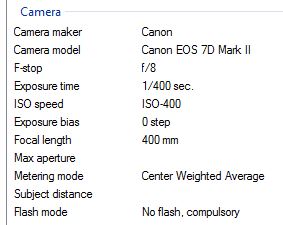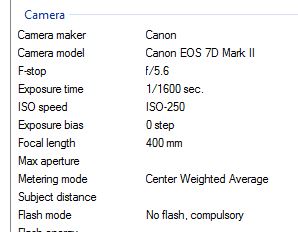Canon 100-400L II focusing question
Feb 22, 2016 18:40:38 #
Jim Bob wrote:
How far were you from the eagles?
I think it's a combination of distance, lighting, and atmospheric conditions. Looks like you are at least 150 feet from the eagles. On a cloudy overcast day near water spray, accurate focusing can be a real challenge. I suggest you take a few shots at that distance on a clear day for comparison.
Feb 22, 2016 20:20:22 #
robertjerl wrote:
I started trying BIF with an EF 70-300 IS USM, no... (show quote)
Thanks, again, Jerry. I hope you had a good nap and enjoyed listening to the birds sing to you!! ;)
Feb 22, 2016 20:25:41 #
Jim Bob wrote:
I think it's a combination of distance, lighting, and atmospheric conditions. Looks like you are at least 150 feet from the eagles. On a cloudy overcast day near water spray, accurate focusing can be a real challenge. I suggest you take a few shots at that distance on a clear day for comparison.
Thanks for the tips, Jim Bob. I appreciate it. And, yes, I think I was more than 150 feet from the Eagles. I'm guessing closer to 300 feet, when I think of the length of a football field.
Feb 23, 2016 08:21:57 #
PattyW60 wrote:
Thanks for the tips, Jim Bob. I appreciate it. And, yes, I think I was more than 150 feet from the Eagles. I'm guessing closer to 300 feet, when I think of the length of a football field.
OK. You should try a monopod or tripod at that distance and perhaps bracket your exposures. Hand-holding is a real challenge for zooms at that distance, even with image stabilization.
Feb 23, 2016 08:36:13 #
I'm going to be following this thread with great interest. I was given this same lens for Christmas and shooting it on a Canon SL1. I'm having similar focusing and learning curves in shooting BIF and wildlife. I find the focus sharpens some when using the tripod (I need to upgrade tripod equipment), but the lens is meant to be versatile in handheld wildlife and sports applications. My challenge other than lighting and distance seems to be the size of the camera. The SL1 has been a trooper for me to get started in the DSLR world - but it seems almost too light. I often wonder if some of the focus problems I'm seeing is from mirror vibration and this would resolve when using another full frame camera body with a battery grip to counterweight the larger lens. I love the lens and where I can reach with it.... But then again - we can never have enough glass - now can we? LOL..
Feb 23, 2016 08:41:02 #
robertjerl wrote:
I started trying BIF with an EF 70-300 IS USM, no... (show quote)
Just wondering. Why are you suggesting she turn the IS off at high shutter speeds? Even at high shutter speeds the IS system for this lens is going to help, and it definitely won't hurt. With these newer lenses there is never a reason to turn the IS off, at least that is my understanding. If there is a reason, I would like to hear it.
Thanks.
Feb 23, 2016 08:44:54 #
Jim Bob wrote:
OK. You should try a monopod or tripod at that distance and perhaps bracket your exposures. Hand-holding is a real challenge for zooms at that distance, even with image stabilization.
I plan to bring my tripod next time. Thanks for your help.
Feb 23, 2016 08:51:26 #
slewis wrote:
I'm going to be following this thread with great i... (show quote)
I love this lens, and I've barely had it a couple weeks. I am anxious to try shooting something at a similar distance, using a tripod. I guess I was thinking if my shutter speed was fast enough, my image would be sharper at handheld. That may simply be unrealistic at longer focal lengths. I've never owned at lens this long, so I'm learning. :)
Feb 23, 2016 09:33:52 #
The 7DII and 100/400 IS II is a great combination for BIF but as with anything new, there is going to be a learning curve and practice makes perfect. In order to get a good quality image, you are going to have to get closer, as others have suggested. If you can get to the point that the subject fills 1/2 the frame, you will be delighted with the quality of the images you can capture. But there are other parameters as well. For me, I do not push the ISO past 800 with this camera. But that is just me and others will disagree. As others have suggested, do a microfine adjustment on the lens and body. This is a must for any new equipment. Additionally, as you progress, you may want to get into the case settings. There are various opinions on this, however for moving objects, it has been suggested to me to use Case 3 with tracking sensitively at -, access/decel at 2, and af pt auto switching at 2. This is assuming you are using AI servo, af surround (5 af points) or more.
Also, fi possible, try to get your subject in your frame as soon as possible, giving the AF system a little time to focus, then shoot. Are you using back button focus? This will help as well. A good tripod with a gimbal head is helpful for stationary and predictable subjects, but when you are trying to capture erratic, quick moving subjects a tripod can be a hinderance. The nice thing about the 7DII/100-400mm combo, it is definitely light enough to hand hold, but getting those forearms and shoulder muscles in shape will help. Anyway, you have gotten a lot of advise, so go out, shoot lots of frames and have fun.
Also, fi possible, try to get your subject in your frame as soon as possible, giving the AF system a little time to focus, then shoot. Are you using back button focus? This will help as well. A good tripod with a gimbal head is helpful for stationary and predictable subjects, but when you are trying to capture erratic, quick moving subjects a tripod can be a hinderance. The nice thing about the 7DII/100-400mm combo, it is definitely light enough to hand hold, but getting those forearms and shoulder muscles in shape will help. Anyway, you have gotten a lot of advise, so go out, shoot lots of frames and have fun.
Feb 23, 2016 09:48:08 #
I will say that shooting subjects at shorter distances, the focal factor is much improved over the lenses I've used in the past. This is especially true when there is time to set up the shot and just that split second to breathe and settle in. However - in bird/wildlife photography - I'm having to make myself take the approach to get the good shot - rather than react and think "OMG it's going to fly or run away - get what I can quickly..."and squeeze off a bunch of shots that may not be so good. So I'm managing the adrenaline rush. I hope I can get into muscle memory where the steady sets in... That comes with practice and confidence over time.
Feb 23, 2016 10:19:53 #
PattyW60 wrote:
Hi. I'm hoping you can help me. I recently bough... (show quote)
If it means anything, I really like the 3rd one! I have never tried shooting BIF (yet!), but reading through the thread it seems that you were shooting at 1/400 sec? If you were relying on the old rule about using 1/focal length for handholding, you need to remember that on the 7DII, that lens was effectively 640mm, and not 400mm. It is the *effective* length you need to use, not the stated length. I am a little surprised that none of the experts has mentioned this, but if this is because I misunderstood, I am sorry... :oops:
Feb 23, 2016 10:28:01 #
[quote=PattyW60]I have the camera data of the first eagle on the ice. F 8 should have been an OK aperture. The formula for shutter speed is 1/mm lens. You shot at 1/400 with 400 mm lens. Just maxed out. I would set shutter to 1/800 or 1/1600 and bump up the ISO to 800 or 1600. David
Eagle in flight is higher ISO and shutter speed, but f stop is 5.6 and that is too wide.
Eagle in flight is higher ISO and shutter speed, but f stop is 5.6 and that is too wide.
Eagle on ice

Eagle in flight

Feb 23, 2016 11:16:47 #
PattyW60 wrote:
Hi. I'm hoping you can help me. I recently bough... (show quote)
Patty,
Take a look at your Canon settings for the capture. Try center point focus, place the center spot in the viewfinder as close to the eye of the bird as you can. Your exposure metering looks okay.
For a focal length of 400mm you need a minimum of twice the FL to shutter speed. (1/800sec plus. Your next logical stop would be 1/1250sec.) You can accomplish this adjustment by setting Aperture to its minimum of f/5.6, or increasing the ISO from 400 to 1600.
If you are using a tripos, or another object to steady the camera/lens, turn off IS.
You indicated you were shooting at the maximum focal length of your lens. Many real good zoom lenses have a problem in calibration throughout their range of focal lengths, the maximum and minimum being the offenders. Try the same type of capture on a static object and set the focal length 1/8 of a turn less than 400mm. (The lens/camera mfg. try hard to calibrate the lens to camera as best as they can and that is usually in the middle of the zoom range.)
Michael G
Feb 23, 2016 11:21:07 #
Armadillo wrote:
Patty, br br Take a look at your Canon settings f... (show quote)
I am sorry. This assumption that IS should be off is simply not correct for newer canon lenses like the 100-400 IS II. This a hangover from assumptions that the IS actually created lens shake when on a tripods, and for older lenses, that may have been the case. But not with the newer lenses. Leave it on!!!!!
Feb 23, 2016 11:27:22 #
PattyW60 wrote:
Hi. I'm hoping you can help me. I recently bough... (show quote)
The best thing is to get as close as possible to your subjects, which in this case will take a lot of patience (hey but that's what photography is all about). Only that will warrant you decent sharpness in your shots. Being very far away will not give you satisfying results and by cropping, you enlarge all the distracting artifacts as well!
If you want to reply, then register here. Registration is free and your account is created instantly, so you can post right away.





